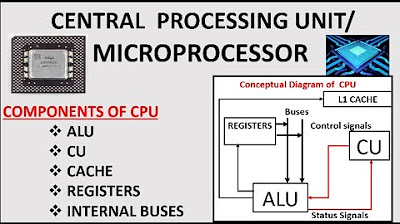The CPU and Von Neumann Architecture
Summary
TLDRThis video offers an introduction to the Central Processing Unit (CPU) and its role in computers. It explains how the CPU processes data using components like the Arithmetic Logic Unit (ALU), control unit, and registers. The video also discusses Von Neumann architecture, where data and instructions are stored together, and the fetch-execute cycle, which describes how the CPU processes instructions. Additionally, it touches on clock speed, highlighting how faster clock cycles improve CPU performance. Overall, it's a basic yet insightful guide to understanding CPU operations and computer architecture.
Takeaways
- 🖥️ The CPU (Central Processing Unit) is the brain of the computer, responsible for processing data, and it is located on the motherboard with a dedicated cooling fan.
- ⚙️ The CPU is made up of three main components: the Arithmetic Logic Unit (ALU), the Control Unit (CU), and the Registers, which all play specific roles in data processing.
- ➗ The ALU handles mathematical and logical operations, performing tasks like addition, multiplication, and evaluating Boolean expressions.
- 🧠 The Control Unit coordinates the CPU's operations, decodes instructions, and manages data transfers within the system.
- 📊 Registers are small, fast storage areas within the CPU used to store data temporarily, making data access more efficient during processing.
- 🖼️ The Von Neumann architecture is the model for most modern computers, dividing systems into four components: memory, ALU, control unit, and input/output devices.
- 💾 In the Von Neumann model, both data and instructions are stored in memory, following the stored program concept.
- ⏱️ The system clock provides a timing signal to synchronize the CPU and other circuits, with the CPU adjusting it to run at a higher frequency, defining the CPU's clock speed.
- 🔄 The fetch-execute cycle is the process by which the CPU retrieves an instruction from memory, decodes it, and executes it using the ALU and Control Unit.
- ⏳ A CPU's performance depends on its clock speed, with a faster clock speed leading to quicker execution of instructions, though bottlenecks may occur if the memory connection is slow.
Q & A
What does CPU stand for and what is its primary function?
-CPU stands for Central Processing Unit. Its primary function is to control the manipulation of data and process it. Essentially, it performs all the computations needed to run software and control other hardware components.
Why does a CPU need a dedicated cooling system like a heat sink?
-A CPU needs a dedicated cooling system like a heat sink because it generates a significant amount of heat while processing data. The heat sink helps to dissipate this heat and prevent the CPU from overheating.
What are the three main components of a CPU?
-The three main components of a CPU are the Arithmetic Logic Unit (ALU), the Control Unit (CU), and the Register Unit. The ALU performs arithmetic and logical operations, the CU coordinates the CPU's activities, and the registers serve as small, fast storage areas for quick access during processing.
What is the role of the Arithmetic Logic Unit (ALU)?
-The ALU performs arithmetic operations such as addition, subtraction, multiplication, and division, as well as logic operations, which involve evaluating conditions as true or false.
How does the Control Unit (CU) assist the CPU?
-The Control Unit (CU) oversees the operations of the CPU by coordinating its activities, managing data transfers, decoding instructions, and ensuring that different parts of the CPU work together efficiently.
What is the function of registers in a CPU?
-Registers are small, fast memory locations within the CPU. They are used to store temporary data and instructions needed during the CPU's operation, reducing the need to fetch data from slower memory, thereby improving efficiency.
What is the Von Neumann architecture?
-The Von Neumann architecture is a model for computer systems that divides them into four components: memory, the Arithmetic Logic Unit (ALU), the Control Unit (CU), and input/output devices. It also introduces the concept of storing both data and instructions in the same memory.
What is the 'Von Neumann bottleneck'?
-The 'Von Neumann bottleneck' refers to the limitation in the speed of data transfer between the CPU and memory. If the connection between them is slow, it can limit the CPU’s performance even if the CPU itself is very fast.
What is the role of the system clock in a computer?
-The system clock provides timing signals that synchronize the operations of the circuits in the computer, including the CPU. It generates a steady rhythm, like a metronome, that allows devices to transfer data and perform operations at the right moments.
What is the fetch-execute cycle in the CPU?
-The fetch-execute cycle is the process through which the CPU retrieves an instruction from memory (fetch), decodes the instruction into its components, and then performs the operation (execute). This cycle repeats for each instruction the CPU processes.
Outlines

Этот раздел доступен только подписчикам платных тарифов. Пожалуйста, перейдите на платный тариф для доступа.
Перейти на платный тарифMindmap

Этот раздел доступен только подписчикам платных тарифов. Пожалуйста, перейдите на платный тариф для доступа.
Перейти на платный тарифKeywords

Этот раздел доступен только подписчикам платных тарифов. Пожалуйста, перейдите на платный тариф для доступа.
Перейти на платный тарифHighlights

Этот раздел доступен только подписчикам платных тарифов. Пожалуйста, перейдите на платный тариф для доступа.
Перейти на платный тарифTranscripts

Этот раздел доступен только подписчикам платных тарифов. Пожалуйста, перейдите на платный тариф для доступа.
Перейти на платный тарифПосмотреть больше похожих видео

2. Arsitektur Komputer Struktur CPU

Gerbang Logika pada CPU | Bab Sistem Komputer | Materi Informatika SMP Kelas 8 | Kumer Fase D

05. Berpikir Komputasional - Model Komputer Von Neumann - Informatika Kelas X

Organisasi Komputer : Struktur CPU

CPU and Its Components|| Components of MIcroprocessor

What is a CPU?
5.0 / 5 (0 votes)
